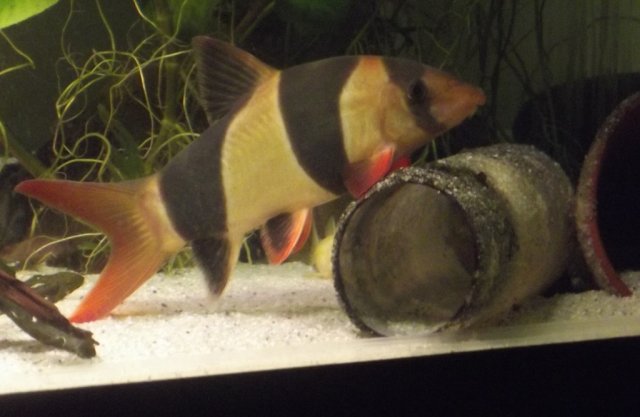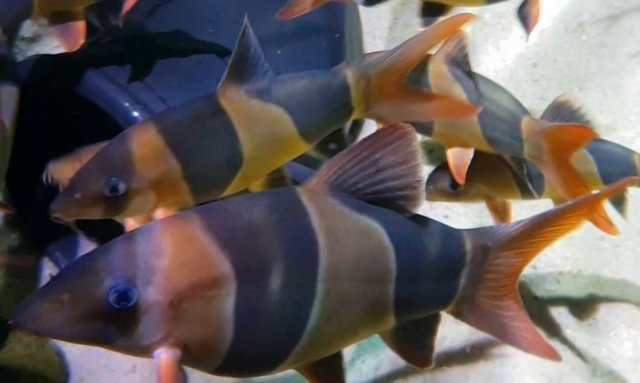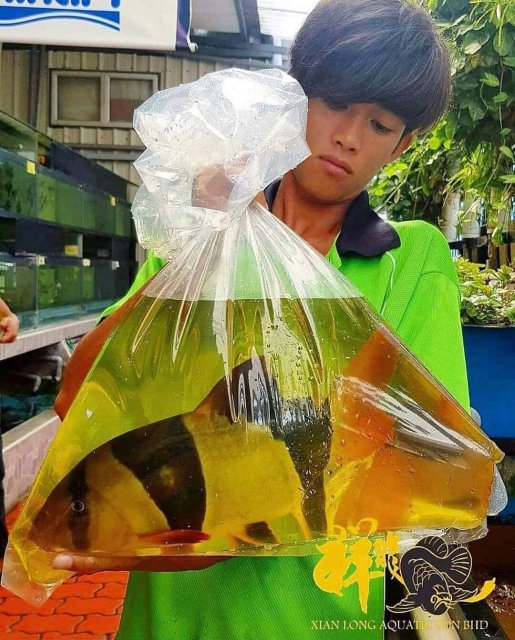BTW - the 14-15" CL's that were in that LFS that I previously described, were in a display tank with a large adult Chili Red Asian aro, so they got a lot of shrimp, fish etc over the 15 years that he had them. They were not slender by any means.
1st hand experience vs Care sheets
- Thread starter jaws7777
- Start date
You are using an out of date browser. It may not display this or other websites correctly.
You should upgrade or use an alternative browser.
You should upgrade or use an alternative browser.
I tried prawns and mussels with mine some years back when I ran out of pellets for a couple of weeks. They starved themselves literally for a week and did not recognize it as food but the rest of the inhabitants were rather happy. I am guessing its because major part of their diet has always been pellets. They go crazy about bloodworms on another hand.
I am generally unwilling to feed them fish flesh as I always kept mine with small fish. They share the tank with about 30-ish harlequin rasboras which were tiny when I bought them, and the SAEs and denison barbs were raised from small juveniles. When I kept them with livebearers, they were no good controlling the population and small platy fry were feeding alongside them. Clowns are not much of a predator so I don't see a reason to feed them food they don't catch in nature.
7 of the loaches a few years back were placed in a tank that had a population of hundreds if not thousands of shrimp. Upon taking the tank down a few months later I found out that the majority of shrimp population survived but all snails were gone.
I am generally unwilling to feed them fish flesh as I always kept mine with small fish. They share the tank with about 30-ish harlequin rasboras which were tiny when I bought them, and the SAEs and denison barbs were raised from small juveniles. When I kept them with livebearers, they were no good controlling the population and small platy fry were feeding alongside them. Clowns are not much of a predator so I don't see a reason to feed them food they don't catch in nature.
7 of the loaches a few years back were placed in a tank that had a population of hundreds if not thousands of shrimp. Upon taking the tank down a few months later I found out that the majority of shrimp population survived but all snails were gone.
I don't want to appear picky here because that is a magnificent specimen of a clown loach. But when measuring fish, as a keen angler, we measure from nose to fork for "true" length, so that beauty is 12"....right? And not 14". To be fair i'd call it 14" and be done with it because whatever it is, 12 or 14, most of us will never have such a thing of beauty in our tanks.
The length of the tail of a large clown loach can be 3 inch when fully stretched, that's taking into account the two 14 inch measured clowns I've seen so far. So standard length is 11-12 inch. However, point is clowns can reach a chunky size and unlike other fish of the same size, they're hyper active fish.
What I also noticed with mine is that as they grow older, the snout gets longer. My largest female used to look like a half moon some years back. Now she's more elongated looking in her snout and body, especially after absorbing her eggs recently. I estimate her being minimum 10-11 years old. I've had her for 6 years but she was already a 5 inch loach when purchased. On the video above from the two largest clowns, she's the one with the stretch marks. And in fact the younger 7 years old female could now have grown larger, looking back at the video.
There's 5 -5.5 years difference between the below 2 pics of the same clown loach. She doesn't have that hump anymore.


What I also noticed with mine is that as they grow older, the snout gets longer. My largest female used to look like a half moon some years back. Now she's more elongated looking in her snout and body, especially after absorbing her eggs recently. I estimate her being minimum 10-11 years old. I've had her for 6 years but she was already a 5 inch loach when purchased. On the video above from the two largest clowns, she's the one with the stretch marks. And in fact the younger 7 years old female could now have grown larger, looking back at the video.
There's 5 -5.5 years difference between the below 2 pics of the same clown loach. She doesn't have that hump anymore.


I don't want to appear picky here because that is a magnificent specimen of a clown loach. But when measuring fish, as a keen angler, we measure from nose to fork for "true" length, so that beauty is 12"....right? And not 14". To be fair i'd call it 14" and be done with it because whatever it is, 12 or 14, most of us will never have such a thing of beauty in our tanks.
When measuring fish their are several methods that one can use, standard length (SL), total length (TL), and even fork length (FL), are routinely used by State & Provincial fisheries as well as in commercial aquaculture circles.

How To Fillet A Striper - Fishing - BoatUS
Instructions on how to properly measure your catch …
In many parts of North America, including the USA, TL is used as a determination on the length of a fish, for anglers. The correct manner in which to get that measurement is to lay the fish flat, and push the tail fin lobes together.
2024-26 Fishing Guide | North Dakota Game and Fish
Table of Contents Licenses Fees General Regulations Bait Definitions and Regulations Manner of Taking Hook and Line Fishing
How to Measure the Length of a Fish

To determine the “total length” of a fish, lay it flat on its side with its mouth closed and measure from the nose to the tip of the tail when the tail lobes are pressed together.
Factors affecting standard weight

Example of fish length measurements. For standard weight equations, the total length is used. This fish is a tarpon.
Length measurements reported for fish may be of the fish’s total length, fork length, or maximum standard length. For standard weight equations, the total length is used.
In some species, male and female fish have different standard weight curves. For example, Anderson and Neumann report different standard weight equations for male and female paddlefish.[5] Some researchers have also reported separate standard weight equations when a species has lentic (living in still water) and lotic (living in flowing water) populations. For example, separate standard weight equations have been published for lentic and lotic rainbow trout.[6]
Personally, in the hobby, I have always used the TL method when measuring a fish.






